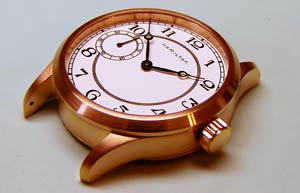Electroplating 101
First a little background on the electroplating process and its basic concepts. Electroplating can be defined as the deposit of a very thin layer of metal “electrolytically” to a base metal to enhance or change its appearance.
Electroplating is done in a liquid solution called an electrolyte (fig.a), also known as a “plating bath”. The plating bath is a specially designed chemical bath that has the desired metal (i.e. silver, gold) dissolved as microscopic particles (positive charged ions) suspended in solution. The plating bath solution serves as a conductive medium and utilizes a low DC voltage (direct current). The object that is to be plated is submerged into the plating bath and a low voltage d. c. current is applied to the bath.
Generally located at the center of the plating bath, the object that is to be plated acts as a negatively charged cathode (fig. b). The positively charged anodes (fig. c) that will complete the DC circuit are carefully positioned at the edges of the plating tank. A power source known as a rectifier (fig. d.) is used to convert AC power to a carefully regulated low voltage DC current.

The resulting circuit channels the electrons into a path from the rectifier to the cathode (object being plated), through the plating bath to the anode (positively charged) and back to the rectifier. Since electrical current flows from positive to negative, the positively charged ions at the anodes flow through the plating bath’s metal electrolyte toward the negatively charged cathode.
This movement causes the metal ions in the bath to migrate toward extra electrons located at the cathode’s surface outer layer. By means of electrolysis, the metal ions are taken out of solution and are deposited as a thin layer onto the surface of the object.
This process is called electrodeposition. Theoretically, the thickness of the electroplated layer deposited on the object is determined by the time of plating, and the amount of available metal ions in the bath relative to current density. The longer the object remains in the d.c. activated plating bath, the thicker the electroplated layer will become.
Now bear in mind this brief explanation of the electroplating process is very basic, the actual processes and specialized equipment as they relate to watch replating are considerably more complex. There are a huge number of technical parameters each having wide variations that must be correctly controlled and monitored in order for the electroplating process to work properly.
[fblock title=”For additional Information…” icon=” fa-book fa-fw”]For additional information regarding electroplating and metal refinishing, be sure to visit our faqs section located on this site. If we can assist you in your custom plating and metal refinishing needs, please contact us.[/fblock]
[row][one_half]
Metal Arts Specialties
[contact tel=”+1 (248) 821-3450″ email=”[email protected]” /]
8AM–6PM EST[/one_half][/row]

